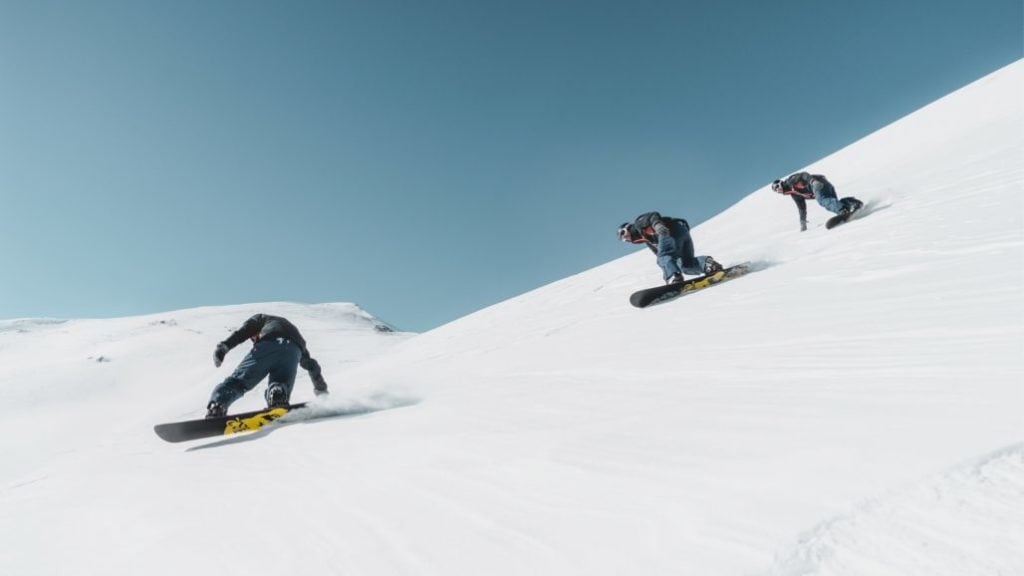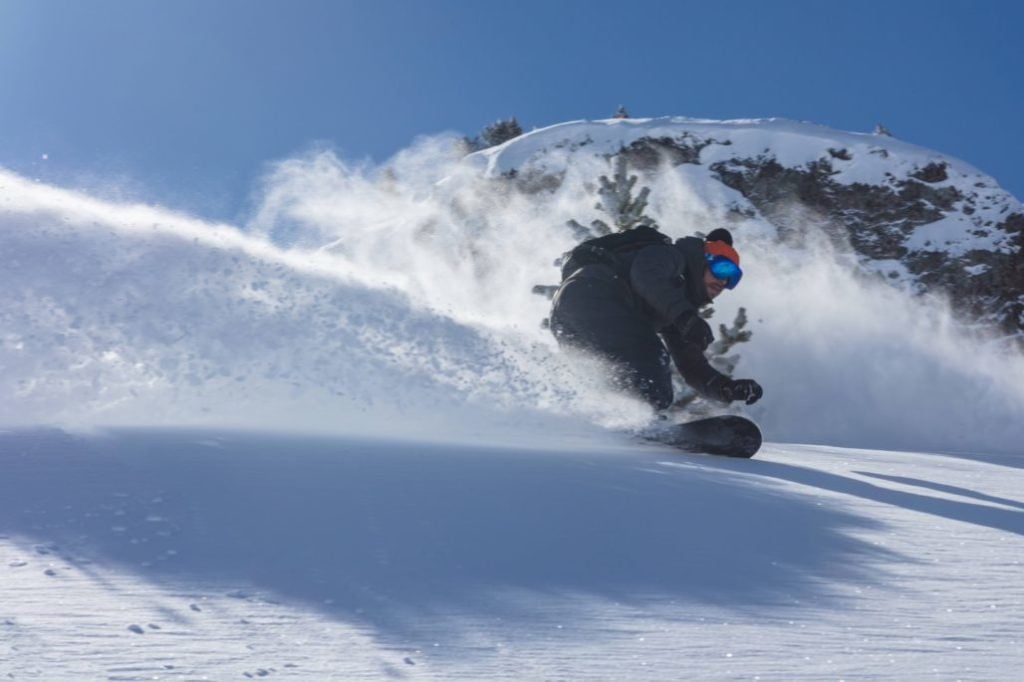What’s your average speed on a snowboard? Do you think you can go faster? Most riders would probably love to beat their current top speed but have no idea how to do it. Or perhaps some are afraid that if they go too fast, they will lose control and eventually fall.
But is there really a way to further increase your snowboard speed? The answer is yes, there are several things you can do to help improve your speed. If you’re ready to learn how, here are some things you need to know.
Table of Contents
The Science Behind Snowboarding

Snowboarding is all about gravity, kinetic, and potential energy. Now, before you roll your eyes and stop reading, this part will not bring you back to your old science classroom. This section will help you understand how snowboarders increase their speed.
The laws of gravity and physics are used in snowboarding. The gravity helps snowboarders gain speed and at the same time maintain balance. When it comes to height in jumps and speed, this is where physics comes in. Snowboarders gain speed when gravity pulls them down on ramps that are curved down on two ends. During this same moment, contact forces push them against the sides.
By pumping the legs up and down, the rider can increase speed. The faster a rider goes, the higher they go as well.
Halfpipe height also plays a part in gaining maximum speed. There is more gravitational energy stored in a snowboarder as the pipe gets taller. As they reach the top, they gain more potential energy, thus making them go faster.
What Is A Typical Speed On A Snowboard?

Snowboard speed varies for every rider, so don’t feel bad if you are on the slower side, especially if you are a beginner. Also, not all snowboarders care about how fast they ride, some of them just really want to have fun and enjoy the snow.
Beginners or intermediate snowboarders can normally reach a speed between 20 to 30mph on an easy run. But it can go up to 40mph during speed bursts in sharp sections. On the other hand, snowboarders riding on flat or cat tracks can ride around 25mph.
However, those who want to reach top speed on a steep groomer can go as fast as 55mph or even more. Professional snowboarders or those who are trained for Olympic games can normally reach a speed of 70mph and above. There are even some who can hit terminal velocity, especially when jumping off cliffs.
The average speed is normally 25mph and can reach 45 to 60mph. However, some may start to lose control at that speed, so be careful to avoid falling off.
Factors That Affect Snowboard Speed

What’s preventing you from reaching your top speed? There are a lot of factors that can affect your speed while snowboarding. Even if you want to reach maximum speed, it may sometimes be difficult. Here are some factors that will either make you go slower or faster.
Weather and Snow Conditions
Weather and snow conditions can greatly affect how you ride. Weather can be unpredictable and you should always be prepared to avoid getting injured. A firm or icy snowpack will help you gain speed while powdery snow might slow you down.
Difficulty Level of Slopes
Slopes can either slow you down or let you ride faster. If you want to go faster, ride on steeper slopes.
Skill Level
Now, don’t expect to ride as fast as the experts when you’re just beginning to snowboard. It takes practice to learn how to speed up. So, don’t be upset if you can’t gain more speed on your first few rides.
Equipment
Now, all boards come in different shapes and sizes as they are intended for different kinds of riders. The right type of equipment will allow you to increase speed over time. A shorter board may not be the best option if you want to go faster. Longer and stiffer boards are better for gaining more speed.
Your Weight
Your weight and even the size of your feet go hand in hand with the kind of snowboard that you have. It also has an effect not only on your speed but also on the overall riding experience.
How to Improve Your Speed

Excited to get on your snowboard and practice? Here are some helpful tips to make you go faster on a snowboard.
Stance
In any board sport, stance is the first thing you need to learn to gain balance and move in the direction you want to go. Same with snowboarding, finding the right stance will help you gain more speed. A forward-leaning stance will help you go faster. Ideally, 65% of your body weight should be on your front foot and 35% on your rear foot. This should help you gain speed.
Surroundings
A crowded trail will definitely slow you down; same with a path that has lots of trees. It’s best to find a trail that is less crowded or has fewer trees or obstacles.
Open Turns
When you open up your turns, your board will point downhill, keeping it in that position will increase your speed. This is particularly helpful when riding on flat roads or cat tracks. Keeping your turns open will not only give you more speed but maintain it as well.
Center of Gravity
Lowering your center of gravity will lessen air-drag and increase your aerodynamics. To lower your center of gravity you need to tuck in your body and place your hands at your back. Your shoulders and head must be facing towards the direction you heading to and you should keep your hips and board aligned.
Quick Stopping
If you are a freestyle rider, you’ve probably mastered the art of quick stopping on slopes. If you want to go faster, this is one skill you need to learn first.
Find A Good Board
A good board will help you increase your speed. You might want to find a longer and stiffer board. The base should also be well waxed to make you go faster. A longer and stiffer board is more responsive and comfortable. It will also help distribute your weight evenly since its edge gives more contact with the snow.
Limit Base Board Contact
By limiting your board base contact with the snow, you will have less friction. The less the friction, the more speed you will gain. You can do this by turning between edges rather than skidding.
Ride With Better Snowboarders
If you want to increase your speed and get better with your overall snowboarding skill, then ride with professionals or if not, at least someone better than you. They will be able to give you tips and at the same time, it would be more fun to ride with people who inspire you to step up your performance.
Ride at Different Conditions
Riding in different weather and terrain conditions will help you learn to control your speed. It will also help you practice and improve your snowboarding skills. This will give you an idea of when and where you can speed up or slow down to avoid injuries.
How To Measure Snowboard Speed
Of course, you want to know how well you’ve improved and compare your speed records. So, how can you track and measure your snowboarding speed? You can do this by using a GPS tracker. Several mobile apps can help you measure your speed. Aside from that, they can also record the calories you’ve burned, routes, distances you’ve ridden, and even the weather and snow conditions.
Features Of A Good Snowboard For Speed

What kind of board should you get if you want to increase your speed? Aside from the tips mentioned above on how to increase speed, finding the right board can make a big difference.
Shape
Find a board that has a longer nose and has a stiffer tail. We’ve learned earlier that leaning forward and putting more weight in front will help increase speed, which works best with boards that have a longer nose. As you go faster, you also need to be in control of your board, and a stiffer tail will help you with this.
Board Length
Longer boards are also better. Now, length does not really add to the speed, but longer boards are more stable than shorter ones, which is what you need as you ride faster.
Board Width
Narrower boards are better for riding faster. This is because they provide less friction to the snow. However, narrower boards tend to be less stable.
Sidecut
Again, stability is important when riding fast. A shallow sidecut will help in holding your edges as you go faster; they are also easier to control.
Camber Profile
Camber profile has the best edge contact with snow which makes it perfect for riding at top speed.
Conclusion
Are you ready to beat your top speed? Learning to ride faster on a snowboard takes time and a lot of practice, especially if you are a newbie. It can also be a bit dangerous, so always practice safety precautions when riding. And remember that snowboarding isn’t always about speed.
Sharing is caring!


